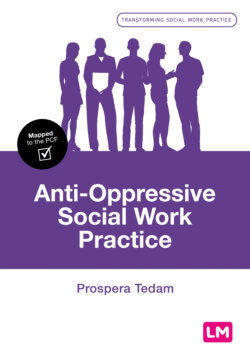Читать книгу Anti-Oppressive Social Work Practice - Prospera Tedam - Страница 26
На сайте Литреса книга снята с продажи.
The SHARP framework
ОглавлениеShaia (2019) introduced the SHARP framework to assist social workers to make sense of oppression within the context of poverty and socioeconomic disadvantage in the USA. Arguing that social workers routinely respond to the outcomes of poverty and oppression with little attention to the oppression itself, Shaia proposes this framework to address this anomaly. She examines the term context blindness (p18) and makes the case for social workers to examine the contexts of people’s lives. She uses an interesting analogy which we will unpick in this chapter. She likens a social worker who is context blind to a doctor who treats a patient with radiation poisoning without asking about the environment which caused the radiation poisoning. Such practice could result in the doctor prescribing treatment but sending the patient back to that very same poisonous environment which caused the initial illness. Social workers should endeavour to identify and intervene at the source of the service users’ problem, and the SHARP framework enables us do this. There are five core components of this framework:
Structural oppression – This requires you, as the social worker, to interrogate what issues in the service user’s ecosystem are impacting on their ability to succeed. These could be lack of access to employment, inadequate or poor housing, unavailability of affordable housing, inadequate access to healthcare.
Historical context – As a social worker, you should consider how a person’s history has and is impacting on their current situation and need. For example, how has intergenerational poverty and disadvantage impacted on the service user? How might previous engagement with social workers impact on the service user’s willingness or hesitation to engage at this point?
Analysis of role – What role will you, as the social worker have in this situation? The framework argues that there is no neutral position and that social workers are either part of the solution or part of the problem. This analysis of your role will further enable you to reflect on why you are in the role. When you avoid discussing and interrogating issues of oppression and discrimination, you are complicit in their oppression and doing little to disrupt it.
Reciprocity and mutuality – In the fourth component of the framework, you are required to consider what strengths the service user possesses, recognising these as valuable assets which they bring to the helping relationship and the quest for solutions.
Power – Finally, what can the service user do to change their situation and the impact of structural oppression? As a social worker, you should consider supporting the service user to examine how they might change their circumstances through activism or advocacy, recognising that what might seem like small simple actions can have a profound impact. The concept of power and powerlessness is so central to anti-oppressive practice that we have dedicated Chapter 3 to examining it in depth.
The SHARP framework is a useful tool for engaging in anti-oppressive social work as it helps to identify and support service users to counter what may be dominant stereotypical views about them. For minority groups, the SHARP framework employs a social justice perspective, enabling social workers to practise in a careful and systematic, values-informed way towards progress and sustainable change.
